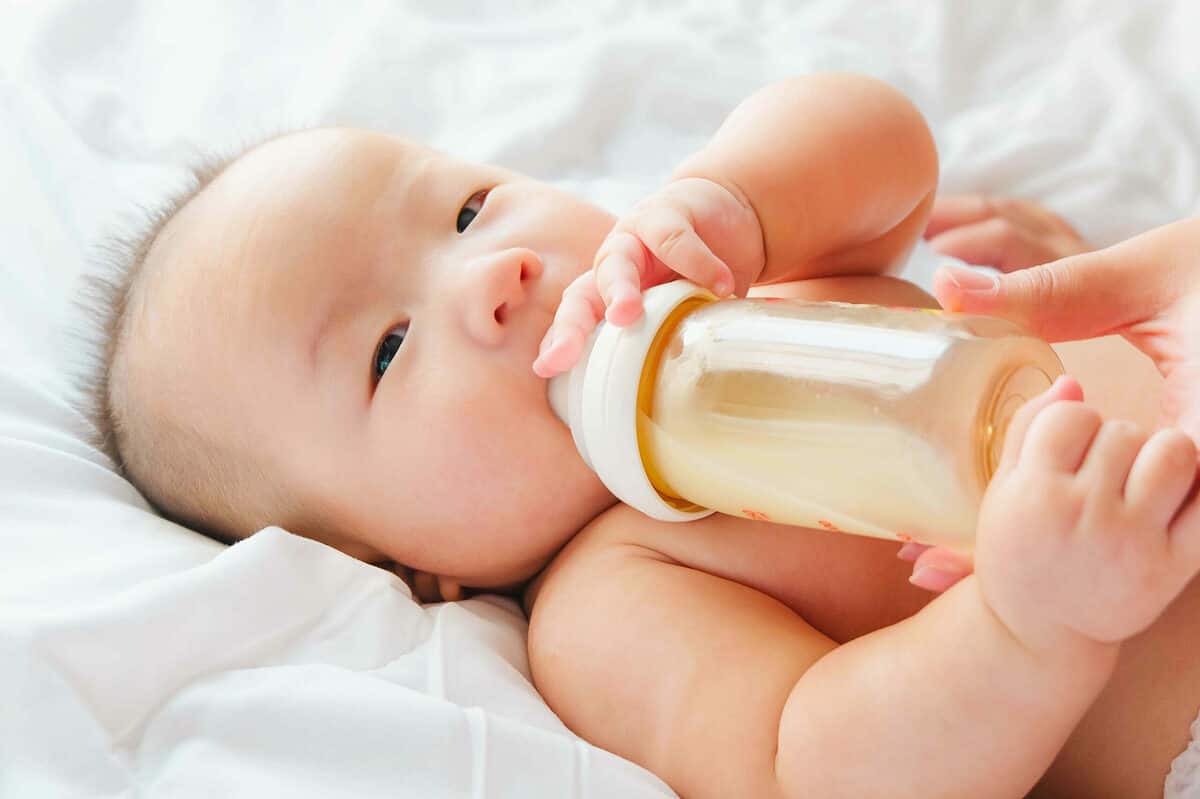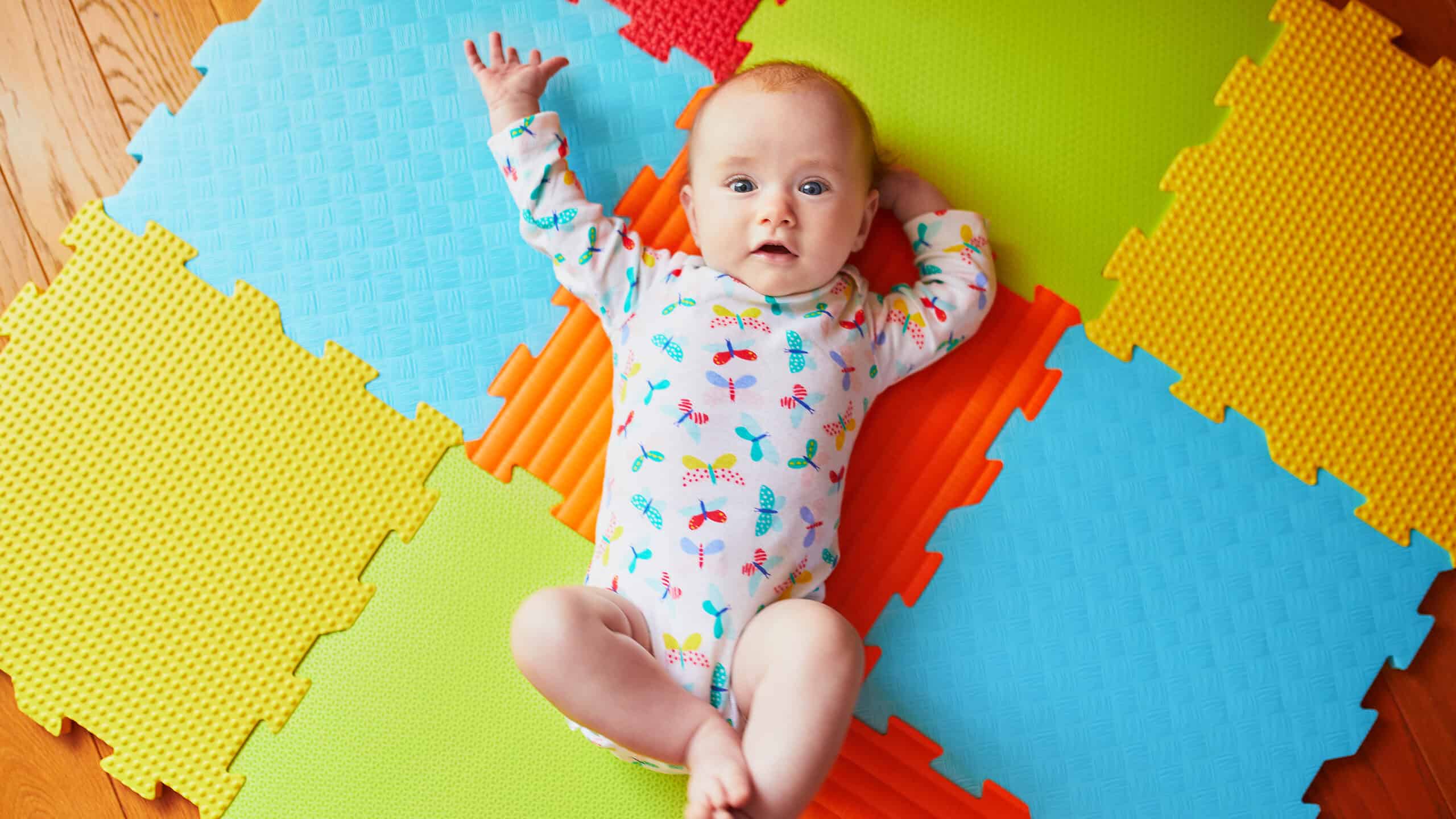At four months along, you will start to see your beautiful baby grow by leaps and bounds. It is around this time that you will notice that your child will be more alert, active, and conscious of their environment. It is truly a wonderful time to be a parent. Whether your baby is approaching this age or you want to know what to expect in the future, then read this guide on the developmental milestones at four months of age.
Key Points
- Your baby will generally need to be fed every four to five hours at this stage. Some babies are even ready to start eating solid food at this age!
- Your baby should start sleeping for longer stretches at this point, and may even sleep through the night!
- Your baby will begin to show more complex emotions, and may begin to roll over on their own.
Four-Month Feeding Expectations
This is the time when your baby will likely eat more at once and go longer between breastfeeding or bottle-feeding sessions. That is because your baby has grown quickly up until this point, and now that growth will slow.

Typically, 4-month-old babies will start to eat less than they have in the past.
©ANN PATCHANAN/Shutterstock.com
Typically, your four-month-old will go four to five hours between feedings and have about four to six ounces of formula or breastmilk during those sessions.
It is also at this time when your baby may have nights where they don’t wake up wanting to be fed, or they may wake up less often but have a bigger feeding. Typically, babies are not ready to start eating solid foods until they are six months old. But, some babies will be ahead of the curve and start at 4 months. You just need to be aware of the signs, which include seeing them sit up on their own and have good head control.
Four-Month Sleeping Expectations

While soothing your child is fine, you can also start sleep training at 4 months old
©Monkey Business Images/Shutterstock.com
The way that your baby sleeps at four months old can go a couple of different ways. In most cases, your baby will start to sleep better and for longer stretches than they have up until this point, sometimes sleeping through the entire night. In general, your baby will likely be sleeping between 12 and 15 hours during a 24-hour period, which includes naps and overnight.
It is a good idea to implement a sleep schedule for when they go to bed at night and take their naps. Most four-month-olds will take between two to three naps per day.
However, in some cases, your four-month-old may actually experience sleep regression, which often occurs because they are going through a growth spurt. If your baby does experience regression, then know that it is normal and it is good that your baby is developing at a rapid pace. By next month, they should start sleeping more peacefully.
Four months is also a good idea to consider sleep training or letting your baby go to sleep without your help. It may be hard to hear your child cry, but when they do close their eyes, they often get better sleep.
Miscellaneous Milestones At Four Months
Your baby will start to show more emotions and be a bit more active, then they have been previously, and you may see some of these milestones at this time. Keep in mind that every baby is different, so if your child does not practice all of these behaviors, there is likely no need to worry.
Playing With Toys
While your baby was probably most entertained by looking at the world around him up until this point, it is at around four months of age when you will see the beginning of a relationship with toys. At this point, babies will start to master their motor skills, and that will include them picking up objects and interacting with them, and having fun in the process.
Getting Upset When Playtime is Over
While you will likely be excited to see your four-month-old start playing with toys, now that they are beginning to understand what playtime is, they may also start to get upset when they have to stop playing. They may cry or show another sign of frustration. While this may seem irritating at first, it is really a sign that they are gaining social and emotional intelligence.
They Will Recognize Familiar Objects
Similar to smiling, your baby will start to recognize and show appreciation for objects and toys that they are familiar with. You may see them smile or make a pointing motion. You can encourage this skill by pointing out items that they like and see if it registers with them.
Rolling Over
It is common to see your baby start to roll over from their stomach onto their back at four months of age. If they can’t go all of the way, then you will see them at least roll halfway. It is very exciting to see this movement, but parents must be cautious. If you are changing your baby, they could roll off of a table or bed. Also, when your baby is able to roll over on its own, it means that you can stop swaddling them at bedtime.
Baby Can Push Up Onto Their Elbows
One of the most exciting developmental milestones at four months of age is the ability for them to perform a “mini push-up.” This is where your child is able to push up onto their elbows so that they are supporting the weight of their head and chest. This ability will get easier as they get closer to five months.
Ability to Hold Head Steady
It may not be at the start of the fourth month, but at some point during this month, you will likely see that your child is able to keep their head up and steady without your support. In addition to holding their head, they will be able to move it back and forth so they can see the world around them. This is the first step to seeing them eventually sit up and walk.
Hand-Eye Coordination
Your baby will start to show incredible improvement at this point, especially when it comes to hand-eye coordination. Many children can now recognize an item in the room that they want and point to it, all in one fluid movement.
Because of this coordination, they will also be more ready to start grabbing at items that catch their interest. This is when you typically see them reaching for your jewelry, your hair, or a nearby coffee cup.
Making Noises/Language Basics
At this point, you will also hear your baby be a bit more audible. It won’t be until six months that they start to say even the simplest words, but you will notice that they start to make sounds with their mouths. To encourage speech in the upcoming months, parents should make it a habit to talk to their baby whenever possible. Talk about anything, from what you're making for dinner to the plot of your favorite movie.
Four-Month Weight and Length Averages
At this age, your baby should basically weigh twice their birth weight. A little more or a little less is okay. However, below are the average sizes for babies at four months. If you have concerns, then speak to their doctor. Your baby may begin growing rapidly at this age, so don't be surprised if they have a sudden growth spurt!
| Boys | Girls | |
|---|---|---|
| Average weight: | 15 pounds 7 ounces | Average weight: 14 pounds 2 ounces |
| Average length: | 25 1/4 inches | Average length: 24 1/2 inches |
What Parents Should Watch Out for at Four Months

Your 4-month-old baby should be able to roll over.
©goodluz/Shutterstock.com
The milestones mentioned here are typical of four-month-old babies, but you may not see all of them at once, and it is typically not cause for alarm. However, there are some red flags that you should look out for. Contact your pediatrician if you notice:
- Your baby won’t smile at people he/she recognizes.
- Doesn’t bring hands to his mouth.
- Difficulty moving one or both eyes back and forth.
- Baby unable to hold head up steady.
- Inability to push down their legs when put on a hard surface.
- Baby doesn’t make many noises or cooing sounds.
There is no doubt that this is an exciting time for your baby. You will see a lot of big changes and developmental milestones at four months of age, so continue to support your child however you can.
What Will Come Next?
Now that your child is four months old, you might be looking beyond their current stage to what milestones will come next! Five months is a big time for your baby, since they've almost reached their first half-birthday! There's plenty of growth that your baby will experience that you can look forward to at this age.
Your baby will begin reacting to specific sounds, like their name and yes/no. Your baby should be able to easily focus on objects without going cross-eyed, can tell the difference between colors, recognizing familiar people and items from a distance, and basic cause and effect.
In terms of size, your baby will reach well over double their birth weight. They'll also gain around one half inch to one inch in height. You may also notice that your baby starts showing a lot more affection to you at this age! It's amazing to see the difference that even one month can make in your baby's development.
Keep up with all of the key childhood developmental milestones here!
The image featured at the top of this post is ©Ekaterina Pokrovsky/Shutterstock.com
